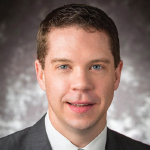As state rheumatology societies go, the Nebraska Rheumatology Society (NRS) is one of the new kids on the block. Established two years ago, the NRS hopes to involve all 27 rheumatologists across the state.
Marcus Snow, MD, a rheumatologist at the University of Nebraska Medical Center (UNMC), Omaha, says the state’s rheumatologists are spread across the state, with the majority in Lincoln and Omaha.
The NRS was launched in 2017, after Dr. Snow learned a bill to legislate biosimilars was up for debate in his state.
“I hadn’t heard of the bill and realized we needed a forum within our state where we could disseminate information about proposed legislation and play a critical role as physician advocates,” Dr. Snow says. “Since the rheumatologists in our state work in different locations and healthcare systems, communication wasn’t an easy task if it needed to be done quickly.”
A Forum Established
With the formation of the NRS, Dr. Snow says rheumatologists in Nebraska now have a pipeline where they can gain information on proposed legislation, leading to successful lobby efforts and a strong presence in the state legislature.
“We can discuss the pros and cons of proposed legislation and ensure that one of our physicians will be present at the state level to testify on our behalf and guarantee our voice is heard,” Dr. Snow says.
In speaking with his colleagues. Dr. Snow learned many of the state’s rheumatologists welcomed the idea of a state rheumatology society. After several conference calls, the society held its first organizational meeting in October 2017.
“As we worked to establish our state society, we found there were a lot of people locally, such as Sam Stinson of the Nebraska Medical Association, who were willing to help,” Dr. Snow says.
When drawing up their bylaws, Dr. Snow says he and his colleagues spoke to other physician groups, including some in other states. After reviewing the other bylaws carefully and considering key points, they used them as a guide to write the NRS’s bylaws.

Dr. Elliott
Jennifer Elliott, MD, a rheumatologist and physician-owner of Rheumatology & Osteoporosis Services, Lincoln, who serves on the NRS board of directors, says the Nebraska Medical Association has played a key role in the success of the NRS, providing guidance in the development of bylaws, securing funding sources and helping with meeting logistics.
“Our small, but mighty, state [rheumatology] society has gathered for three meetings, and we have hosted guest speakers from the ACR and other experts in the field of rheumatoid arthritis treatment and vasculitis,” Dr. Elliott says. “We have been thrilled with our membership turnout for these meetings.”
In the future, Dr. Elliott says the NRS would like to promote collaboration among other professionals in the rheumatology field.
“I’d love to see a venue where office managers, infusion nurses and other key members of a rheumatology practice could meet at the same time as the NRS to talk about best practices in their field and share information,” Dr. Elliott says. “I think we’re stronger when we all work together.”
Improving Access
In a state with just under 2 million residents and 664,300 living in rural areas, Dr. Snow says access to rheumatology care is a big issue in the state. A UNMC report found that 13 of Nebraska’s 93 counties have no primary care doctor, much less access to specialty care, such as rheumatology.1

Dr. Snow
“In my clinic, I’ve had patients who have made a three-hour drive for an appointment,” Dr. Snow says. “Wait times for a rheumatology appointment can often be several months in Omaha, and while this is a national issue as well, our association has been looking at ways to improve care to patients who live in rural areas.”
Dr. Snow and his colleague, Alan Erickson, MD, a rheumatologist at UNMC, both conduct rheumatology outreach clinics twice a month in two of the state’s rural areas. Dr. Erickson conducts clinics in West Point and Fall City, while Dr. Snow offers an outreach clinic in Columbus. Both rheumatologists have also offered educational programs in the outreach communities.
Two rheumatologists at the Creighton School of Medicine, Omaha, also provide outreach clinics.
“We’re striving to provide accessible care to patients in areas where they live and work,” Dr. Snow says.
The NRS was launched in 2017, after Dr. Snow learned a bill to legislate biosimilars was up for debate in his state.
Preparing for the Future
In addition to access, Dr. Snow says the Nebraska Rheumatology Society is also looking at how the projected rheumatologist shortage will impact the state and how physicians can work together to encourage resident involvement.
According to a 2019 Nebraska Department of Health and Human Services, State Unit on Aging report, the demographics of Nebraska are changing.2 By 2035, the state’s 60 and older population will increase by 36%.
This coincides with the Centers for Disease Control and Prevention’s (CDC) projection that the number of Americans with rheumatic diseases is on the rise, with 78 million adults being diagnosed with rheumatic diseases by the year 2040.3
“We’re looking at how we can highlight rheumatology as a career path before medical students narrow their focus to other specialties,” Dr. Snow says.
In addition, Dr. Elliott says the NRS hopes to include advanced practice providers, including physician assistants and nurse practitioners, in their outreach efforts.
“We’re fortunate to have two excellent medical schools in our state that are continuing to expose medical students and residents to careers in rheumatology,” Dr. Elliott says. “Additionally, the NRS and others are working with advanced practice provider programs to give rheumatology lectures and encourage their students to do clinical rotations.”
Linda Childers is a health writer located in the San Francisco Bay Area.
References
- Wilson FA, Wehbi NK, Larson J, et al. The status of the healthcare workforce in the state of Nebraska. University of Nebraska Medical Center, Center for Health Policy. 2018 Feb.
- Nebraska state plan on aging, October 1, 2019—September 30, 2023. Nebraska Department of Health and Human Services, State Unit on Aging, Division of Medicaid and Long-Term Care. 2019 Jun 19.
- Barbour KE, Helmick CG, Boring M, Brady TJ. Vital signs: Prevalence of doctor-diagnosed arthritis and arthritis-attributable activity limitation—United States, 2013–2015. MMWR Morb Mortal Wkly Rep. 2017 Mar 10;66(9):246–253.

